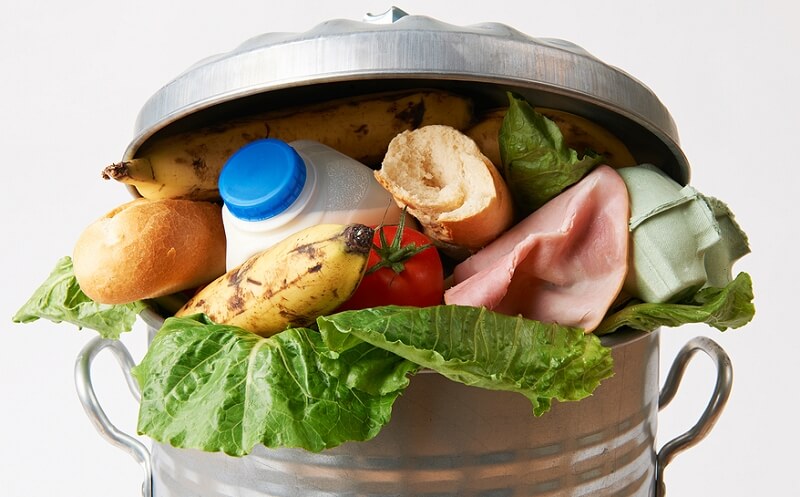The numbers are staggering.
In the good old United States of America, our landfills are full of food waste—up to 40 percent. The United States Department of Agriculture (USDA) Estimates we Americans waste 31 to 40 percent of our post-harvest food supply—this is food thrown out from our refrigerators. Furthermore, we throw food out of the plates in our kitchens, from restaurants, and our farms themselves. So, how much food is this?
According to the USDA, in 2010, the U.S. pitched 133 billion pounds and $161 billion worth of food!
In his book, American Wasteland, activist and author Jonathan Bloom estimates the U.S could fill a college stadium with the amount of food it wastes … in just a day. Multiply that by 365 days, and anyone can see we Americans throw out too much edible food, even while other Americans (one in eight) fight to feed themselves and their families. Not only is this a waste of food that could feed the hungry and is a loss of a lot of money, but also, while this food slowly rots in our landfills, it creates methane gasses, which release into the atmosphere (and we know that isn’t good).
So, what is going on?
Simply put, Americans are picky eaters. Experts at the USDA and the National Resources Defense Council (NRDC) say Americans waste food in their homes because they buy too much at one time, don’t store it correctly, and, well, if it doesn’t look perfect or is past its “best used by” date throw it away – even if the food is totally edible.
In the business world, Americans only like to purchase the highest quality food products. Therefore, foods that are not the right size, misshapen, bruised, or blemished are not sold to the public. In her 2016 article for the Huffington Post, “Farm To Landfill: The Cost Of Food Waste In America,” Kamayani Gupta wrote, “Workers and packing institutions are trained to skip over small, misshapen, or otherwise ‘ugly’ produce because the size and cosmetic quality of the crop do not meet the standards of buyers, leaving 30 percent of products to be discarded.”
And further, “Absurd stories are told by farmers on the quantity of produce left behind. Interviews with peach farmers found that they can’t sell eight out of the ten peaches grown cannot be sold due to the unmarketable appearance of the fruit. A cucumber farmer estimated that fewer than half of the vegetables he grows leave his farm and that 75 percent of the cucumbers that stores remove before sale are still edible. Perhaps most egregiously, a large tomato-packing house reported that they could fill a dump truck with 22,000 pounds of discarded tomatoes every 40 minutes. Looking specifically at fruits and vegetables, 1-4 percent of produce is left in the field after harvesting, up to 30 percent of the product is removed during packaging, and 20 percent is lost during production.”
What can be done?
While total elimination of food waste is impossible, there is much going on and more to be done—from individuals to restaurateurs to larger-scale composting operations. For example, chefs like Mads Refslund, a Dane now in New York, use locally sourced foods and make dishes with little waste at their restaurants. In the Bronx, food distributor Baldor reportedly processes a million pounds of produce a week. In the past, anything leftover–from carrot peels to strawberry tops–went into the trash. Now, every week, 150,000 pounds of what would have been food waste become what the company calls “sparcs” (scraps spelled backward). Carrot peels, for instance, are bagged into 10-pound portions and sold to chefs. Also, educational centers like Orchard Community Learning Center in Phoenix use grinding and screening machines to help make compost.
The Environmental Protection Agency EPA) is promoting its Food Recovery Hierarchy which individuals and organizations can follow to help reduce food waste. According to the EPA’s website, the top levels of the hierarchy are the best ways to prevent and divert wasted food because they create the most benefits for the environment, society, and the economy. The inverted pyramid has five levels; the uppermost is Source Reduction: “Everyone creates wasted food, but it is just as simple to not create it. Both businesses and individuals can learn to effectively prevent the flow of wasted food by taking simple steps such as making grocery lists, inventorying supplies, and buying less.”
They are heading down their other tiers to keep food out of the landfills: Feed Hungry People, Feed Animals, Industrial Uses (like making biofuels), and Composting.
The EPA’s website on composting says, “Even when all actions have been taken to use your wasted food, certain inedible parts will still remain and can be turned into compost to feed and nourish the soil.”
There are a ton of websites, books, and magazines describing methods for homeowners to compost and how to use the compost in their gardens. For more information on the EPA’s Food Recovery Hierarchy, go to www.epa.gov/sustainable-management-food/food-recovery-hierarchy.
For more on the USDA’s Food Waste Challenge, go to www.usda.gov/oce/foodwaste.
To read an article about Chef Mads Refslund’s new venture, go to www.surfacemag.com/articles/mads-refslunds-waste-free-world.
To read more on the Baldor food processing company, read this article, www.fastcompany.com/3068676/how-a-giant-processing-plant-eliminated-food-waste





Leave a Reply